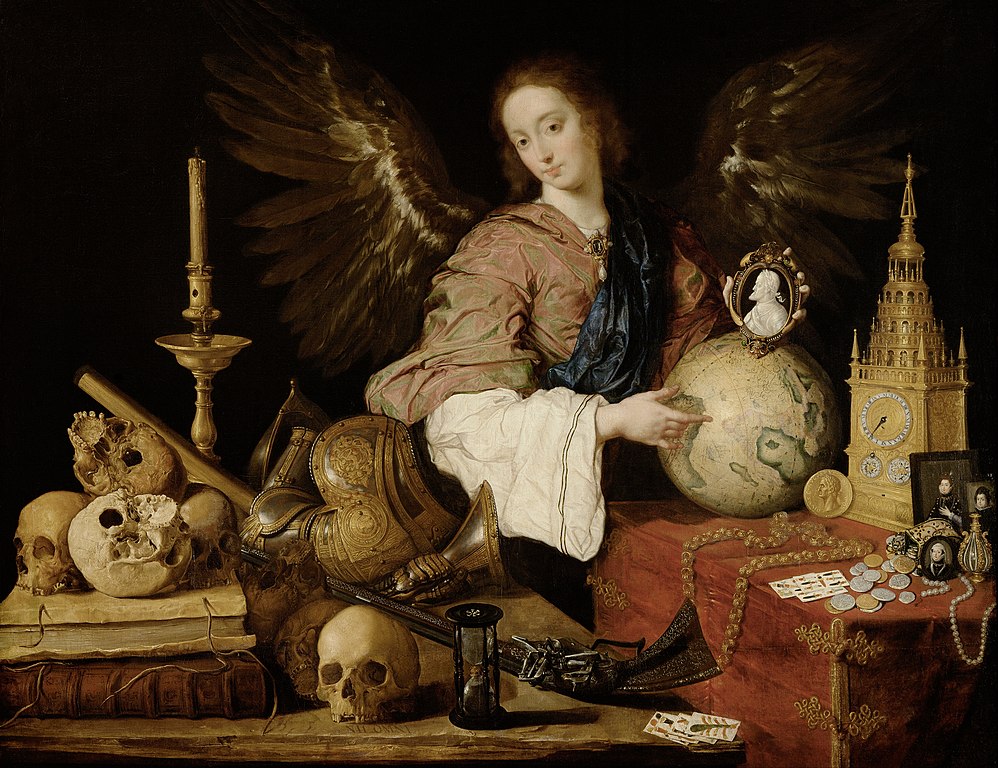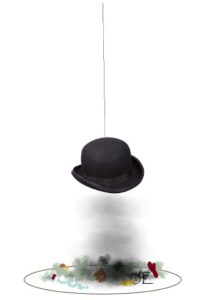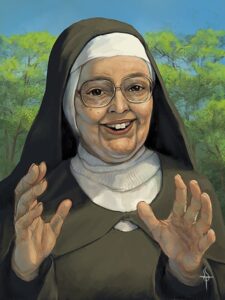
“Communication,” an exhibit based on a collaboration between the Writers Alliance of Gainesville (WAG) and the Gainesville Fine Arts Association (GFAA), generated quite a bit of interesting conversation. Authors were either pleased or disappointed by the work created in response to their offerings.
Some of the art followed classic, concrete impressions, while others were wildly abstract, whimsical, cartoonish.
To my mind, this eclectic mix of styles and media (oil, acrylic, pencil, charcoal, spray paint, flat, textured, bas-relief, or sculpture) made for an interesting exhibit in three parts: the art, the writing, the pairing of the two.
And in discussing the artwork, I realized my gratitude for all the art classes I’ve taken in my life. Sadly, I have only mediocre talent for all that, but I cherish the experience and the knowledge about art because it bleeds into writing. Point of view. Framing a situation. Mood. Tone. Subtlety. Metaphor. Texture. Sensory impressions.
In the same way that an artist has the option of caking on layers of paint or stippling, to determine how fine or broad the lines are, a writer draws the reader’s attention with subtle hints or broad exposition. Symbolism. Metaphor. What does a red hat mean or a gray sky?
Art and Writing: Kissing Cousins?
There is so much similarity between visual art and the art of word craft.
I took an art class in college all about space and perspective. At the time, I thought it seemed goofy. Most of our homework involved cutting and arranging foam core boards. Lots of frustration cutting with an Exacto blade. Gluing pieces small pieces to a larger piece to create a 3D abstract. Lacking fine motor skills, patience for details, and tolerance for tedium, I felt transported back to grade school, working one level up from paper dolls. Could hardly believe my grade depended on foam core board cutouts.
But what value did these exercises convey?
I learned that from one side of the piece, I saw one pattern. Looking at it from the center, I saw something else. From the other side, something else again. It appeared to change as I moved around it. There was space and empty space. Translating this to words, what is said, what is unspoken? What is there in the spaces in between? Is the empty space truly empty?
The relationship between artist and viewer parallels that of author and reader. What sings to and gives thrill chills to one person might repel another. I’ve chucked best-selling books across the room in disgust and frustration. Obviously, many readers loved the ones I hated. Or otherwise, these books wouldn’t be bestsellers!

Connecting with the Artist, the Writer
Once upon a time, not so long ago, I visited a modern exhibit in a museum. The walls were white. The pieces were ugly. I was ready to just wander on through to the next room when suddenly, I GOT IT. The artist, Stephan Dillemuth, creates ugly, modern, dystopian vanitas sculptures. Vanitas is historically a composition style meant to reflect the futility of celebrating accolades and excesses of life. The classic depictions usually include a skull, jewels, a quill pen, a banquet of decaying food, a musical instrument, coins, signs of stature like military badges, diplomas, certificates, etc.
Dillemuth’s designs were of drywall chunks, coins, broken dolls, jewelry fragments, and so on, looking much like the aftermath of an earthquake. My favorite piece featured a hat suspended from the ceiling. It hovered over a pile of detritus, the shadow of the hat swaying across a pile of junk: a torn-up wallet, a shoe, a purse, coins, bits of bones.
I had not expected to love this exhibit. I loved it so much, that I danced around like a maniac, “Yes! I get it! Oh, how clever!” I laughed to see a figurine of a blacksmith mounted on a bit of mirror, on a turntable. Round and round endlessly pounding and getting nowhere. “Brilliant! I love it!” I exclaimed.
The security guard came forward and asked me to clarify my joy. I explained about the vanitas style. He nodded. “I know that you are right. I have spoken to the artist. I want you to know that you are the first person to react in this way. Most people just walk through quickly.”
Communication
Communication between the artist and viewer, the author and reader. Sometimes the connection is deep. Other times, there is no connection. Each brings something to the meeting. Will they get each other?
There is another thing that I haven’t underlined yet, and that is experiencing the exhibit as a whole. Personally, I loved the variety of works from the whimsical and abstract to the concrete. Are you expected to love each piece madly? Of course not! But as a whole, it’s an eclectic collection, a kaleidoscope of textures, colors, tones, emotions.
If we do another collaboration, we will have a disclaimer and a sign-off sheet before the work is accepted. It will explain that the author and artist are both creating, and as such, one may not impose restrictions or parameters on the other. Signing off on the agreement will be a statement that by participating, you are open to a vulnerability but also grateful for the exposure of getting your work out there to the public eye. There was no submission fee for these exhibits. One’s work is available to see as part of an overall exhibit. This should be a perk, a gift, and something to celebrate. The matching work may or may not float your boat. Perhaps you imagine being matched with a Rembrandt, Degas, or Constable. You will be dismayed, then, to be matched with Pollack-like splotches, Warhol-esque pop art, or a plain gray canvas with lines as if from a notebook in the style of Agnes Martin.

I have Sister Wendy Beckett to thank for her way of seeing and appreciating Martin’s work.
If you haven’t taken an art appreciation class in a while, one of the very best teachers of appreciation is the late Sister Wendy Beckett, a nun whose savvy on art from primitive Lascaux cave art to the Post-Modern era knows no equal. She disengaged herself from a vow of silence and isolation to travel the world and discuss art. Many of her videos are available on YouTube. Her wisdom and insight are phenomenal, perhaps divinely?
That is how art and literature work, folks. Not all art appeals to all; not all writings appeal to all. As the French say, “Á chacun son goût.” (To each, their own.)
[Editor’s note: WAG would love to see articles on any and all topics of interest to writers. Please send your ideas or finished pieces to Cynthia D. Bertelsen at BlogEditor@writersalliance.org for consideration. Remember: these posts are more than just posts, for they are actual articles and can be cited in your CV/résumé in the same way you would a short story, essay, or any other writing credit you may possess.]

Mary Bast
Thanks so much for this post, Jess; it’s really helpful and would be a good piece to recirculate if WAG collaborates again with a GFAA art show. While the two collaborations (so far) have been free for the writers, the artists have paid the usual entry fee (typically $30), and GFAA receives a commission on any sales of the artwork exhibited. Though artists in need can win scholarships, these fees are standard for art exhibitions, to help cover costs of maintaining the gallery, advertising, etc.
Jessica Elliott
Thanks, Mary. Did not know that artists had to pay a fee or that a portion of proceeds goes to GFAA and I’ve been involved in the projects! Don’t think that’s widely known. Makes sense.
I hope we do further collaborations. The discussions are always so interesting! Yes, we will give folks an idea of what to expect and have participants sign a form acknowledging the goals, boundaries, expectations, etc.
Patsy Murray
Jess, I LOVED this piece! My husband Gil was an artist and also a writer and member of WAG. I’m a musician and writer, and we had many conversations about the relationships between the three arts. I hear rhythms in art and see colors in music. I really enjoyed your descriptions of what you learned in art classes and how it relates to writing. I had never thought about techniques like space, framing, subtleness or directness and the others you mentioned. All of that also applies to music. Thank you! I will pass your article on to Gil’s daughter, also and artist and writer.
Jessica Elliott
Thanks, Patsy. Without looking it up, sounds like you’ve got synesthesia–pretty sure that’s what it’s called. Knew a woman in high school who saw colors for letters and the name Tom was red, white and blue for her. Vasily Kandinsky heard music in color, which is such a pity… only he knew what his art sounded like. I got to see a massive Kandinsky exhibit at the Tate and could have cried. I’m sure he would have been overwhelmed to be in room after room with his massive paintings. We were all deaf. 🙁
Please do check out Sister Wendy. She’s so lovely, smart, warm, thoughtful, inciteful. Had I had more talent, I would have loved to have pursued an art major. I took a film class– made me realize that every second of film was a choice. Every frame. How close, wide angle or close up? What is framed and what is out of view? Are we seeking to make a harmonious or discordant image? Hitchcock shook the world with odd camera angles. Things going on out of view of the camera. Shadows. Film noir is famous for the spooky effects of dark and light. I could go on. I love art. I see my stories in my head, like films. When I stop typing, the scene freezes while I think of what happens next. Then it moves again.
Tamm Walters
When you send your art out in to the world, be open to what the world sends back. What is there other reason to create if not to connect?
Penny Church-Pupke
Hi Jess,
What a fabulous post I never considered the connection between art and writing until now. As I read your post I thought Wow! That is so cool. Thanks for opening up a whole new dimension of experience.e
Penny Church-Pupke
Hi Jess,
What a great post. I never considered the connection between art and writing until now. As I read your post, I thought Wow! That is so cool. Thanks for opening up a whole new dimension of experience for me.
Jessica Elliott
Yay! Glad you liked it. There truly are lots of similarities. 🙂
Marie Q Rogers
Jess, thank you for this interesting perspective. Food for thought.
Bonnie Ogle
I second the motion this post be recirculated when we collaborate again with GFAA. I stopped by GFAA (fun exhibit, self portraits) and chatted with Katy Lemie about several issues we need to address before our next collaboration: Can/should the artist include the written piece with the art sale? Can the artist incorporate the written piece into the artwork? Should the writer get some portion of the sale? I’m going to suggest at Sunday’s board meeting that we get together with GFAA and set some guidelines. We learn as we go!
Jessica Elliott
I spoke with Katy some at the time of the event. Yes, need to discuss prior to another event. I’d like to be part of that conversation. I think one thing that WAG folks were unaware of when grumbling about the artist getting to sell their work while the writers don’t get any financial reward is that the artists are paying membership fees to GFAA and also had to pay a fee to submit their work. WAG writers did not. WAG writers got free exposure to have their work on the wall for free for the duration of the exhibit. I really hope we can do these again, but yes, some ironing out and more info up front to parties wanting to participate about ground rules and expectations.